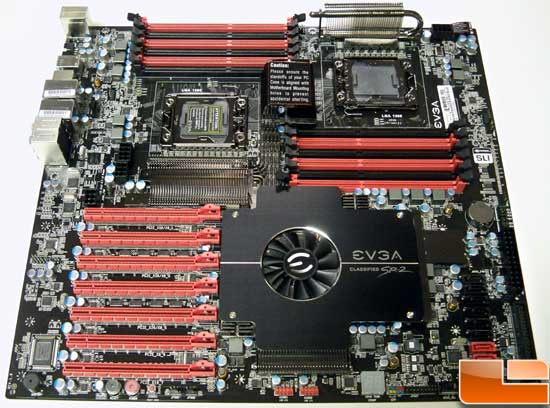EVGA Classified Super Record 2 SR-2 Motherboard Review
The Ultimate Enthusiast Motherboard, EVGA SR-2

As any enthusiast will tell you, more is always better. Automotive enthusiasts are always looking for every last horsepower that can be squeezed out of their setup. When it comes to computer enthusiasts, we look for every MHz that can be gained, even if it means spending triple the amount of money for the latest and greatest cooling device.
When Intel and AMD launched dual core CPUs, PC enthusiasts everywhere frothed at the mouth with the thought of having so much processing power. Of course, nowadays we have 6 core CPUs on the extreme end of desktop computing. Sure, there are 8 core CPUs on the server side of things, but those are extremely expensive and would perform poorly (comparatively) in a desktop environment.

Today we are taking a look at the ultimate enthusiast motherboard. It takes a blend of desktop processor overclocking features and multiple graphics cards, and mixes it with server processors to give you the baddest system you can get your hands on, the EVGA Classified SR-2. The EVGA Classified SR-2, or Super Record 2, uses an Intel 5520 server chipset to give us the power to run two Intel Xeon server processors. The LGA1366 socket is home to both the Intel i7 900 series desktop and Xeon 5500 (Quad core) and 5600 (Hex core) CPUs. To anyone dreaming of dual Intel hex core CPUs cranked up to 4GHz+: your motherboard has arrived.
The idea of overclocking Xeons isnt really new; you may remember that in 2008 Intel released a dual socket motherboard aimed at enthusiasts with Skulltrail. While it was impressive performance-wise, the fun factor was severely hampered by the use of FB-DIMMs. Not only are they power hungry and hot running, they limited overclocking potential to bumping up the CPU multiplier. Of course, there was only one LGA 771 Xeon, the prohibitively expensive QX9775, that came with unlocked multipliers. The EVGA SR-2 has no such constraints; any 1366 Xeon will work and you can use just about any DDR3. With that in mind, you can start to see then that the EVGA SR-2 has a lot going for it with a large number of options.
There are a few differences between the i7 and Xeon processors, the most important of which is that the Xeon has two QPI links while i7 has just one. That second QPI link allows the processors to be used in a dual socket motherboard. For those of you that got excited about having a pair of i7 930s in the SR-2, sorry to burst your bubble but its not going to work. The SR-2 can run only a single i7 CPU so such a setup would defeat the purpose and be a complete waste of money. Oh yeah, the cost! The EVGA SR-2 comes in at a cool $569 plus shipping. While at first this may seem like an overpriced motherboard, you have to consider that this is the ONLY dual socket mainboard for socket 1366 with any sort of built in overclocking functions. This beast was meant to be benchmarked hard and torture tested.
Lets have a look over the specs before we get to the details on the EVGA SR-2.
- Based on Intel 5520/ICH10R chipset
- Supports Dual QPI Socket 1366 Intel Xeon 5600 and 5500 Processors
- 12 x 240-pin DIMM sockets
- Triple Channel DDR3
- Maximum of 48GB of DDR3 1333MHz+
- 1 x UltraDMA133
- 8 x Serial ATA 2x600MB/sec / 6x300MB/sec with support for RAID 0, 1, 5, 10, JBOD
- 8 Channel High Definition
- 2 x 10/100/1000
- 2 x USB3.0 ports
- 10 x USB2.0 ports
- HPTX Form Factor
- Length: 13.6in – 345.4mm
- Width: 15in – 381mm
- Limited Lifetime warranty with registration within 30 days of purchase.
Right, on to the photos and layout!

Comments are closed.